PALLASITES: A Rare View
Part II
The pallasites displayed on this page are seldom represented in private collections, and some not at all. All photos are courtesy of Dr. J. Piatek.
I’d like to express my appreciation to Dr. Piatek for sharing his rare
pallasiteOne of two main classes of stony-iron meteorite, the other being mesosiderites. Pallasites are igneous in nature and characterized by crystals of olivine, sometimes peridot (green gem quality clear olivine crystals), embedded in a matrix of Fe-Ni metal. The type specimen, weighing 680 kg, was found in the mountains near Click on Term to Read More collection on MeteoriteStudies.com.
Admire—PMG
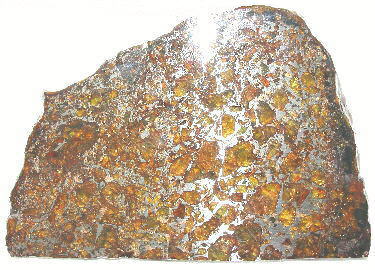
Initially, a single ~6 kg pallasite was found during plowing in Kansas, USA in 1881. Subsequent recoveries increased the TKW to over 80 kg. Aptly named, Admire contains an abundance of colorful fractured and splintered olivines, and it exhibits the progressive disintegration of large polycrystalline
olivineGroup of silicate minerals, (Mg,Fe)2SiO4, with the compositional endpoints of forsterite (Mg2SiO4) and fayalite (Fe2SiO4). Olivine is commonly found in all chondrites within both the matrix and chondrules, achondrites including most primitive achondrites and some evolved achondrites, in pallasites as large yellow-green crystals (brown when terrestrialized), in the silicate portion Click on Term to Read More areas into smaller fragments. The photo shown above is a 400 g partial slice, acquired from the Robert Haag Collection, previously obtained from the American
MeteoriteWork in progress. A solid natural object reaching a planet’s surface from interplanetary space. Solid portion of a meteoroid that survives its fall to Earth, or some other body. Meteorites are classified as stony meteorites, iron meteorites, and stony-iron meteorites. These groups are further divided according to their mineralogy and Click on Term to Read More Laboratory in Denver.
Molong—PMG
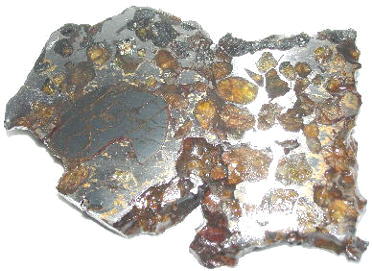
A single
104.3 kg pallasite was found by Thomas Farrell on his farm at Molong Creek in New South Wales, Australia in 1912. Half of the meteorite was ultimately acquired by the Australian Museum in Sydney, but the whereabouts of the other half is currently unknown. Peridot from this pallasite has been confirmed as the first to be faceted, which was done by the Lapidary Section of the Department of Mines in 1916. The photo shown above is a 103 g partial slice, acquired from the Robert Haag Collection, previously obtained from the Australian Museum.
Albin—PMG
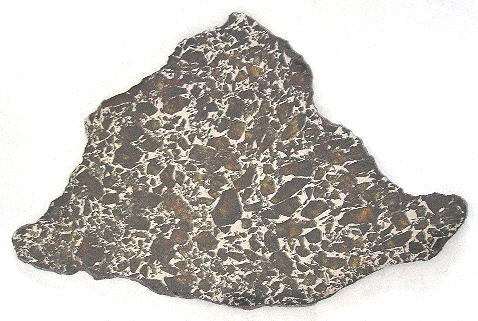
A single 37.6 kg pallasite was found in Wyoming, USA in 1915, and recognized as a meteorite in 1935. Further masses have been recovered since then. The photo shown above is a 285 g slice, acquired from Al Mitterling Meteorites.
read more >>
Huckitta—PMG-am
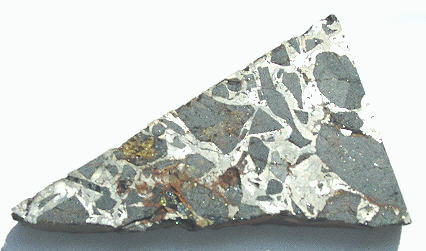
A 1,084 g pallasite was found in Northern Territory, Australia in 1924. Subsequently, a larger mass of 1,411.5 kg along with over 900 kg of iron shale was found ~225 km away at Huckitta, where it had been lying for thousands of years. Most of this pallasite has been severely weathered—FeNi-metal is transformed into
hematiteFe-oxide mineral (Fe2O3) that may be the major cause of the red color on Mars. Coarser-grained gray hematite has the same chemical formula as the red variety, but a different crystalline structure. Deposits of gray hematite found in the Terra Meridiani region of Mars may suggest that water once circulated Click on Term to Read More and
magnetiteFe oxide, Fe2+Fe3+2O4, containing oxidized iron (Fe3+) found in the matrix of carbonaceous chondrites and as diagnostic component in CK chondrites. In CK chondrites, magnetite is typically chromian, containing several wt. % Cr2O3. Click on Term to Read More. Huckitta has very high Ge and Ga contents, elevated Pt, W, and Ir, and a lower
AuThe astronomical unit for length is described as the "mean" distance (average of aphelion and perihelion distances) between the Earth and the Sun. Though most references state the value for 1 AU to be approximately 150 million kilometers, the currently accepted precise value for the AU is 149,597,870.66 km. The Click on Term to Read More content compared to other main-group pallasites. The photo shown above is an unoxidized 257 g partial slice, acquired in trade from the United States National Museum, Smithsonian Institution.
read more >>
South Bend—PMG
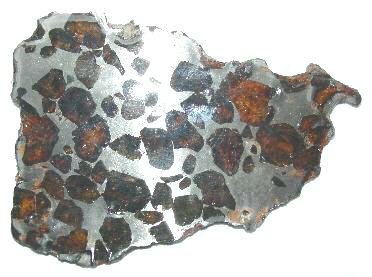
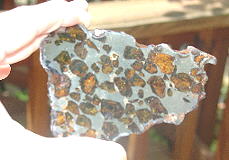
A single 2.5 kg pallasite was found during plowing in Indiana, USA in 1893. The photos above show a 126 g slice, acquired from the Robert Haag Collection, previously obtained from the Field Museum of Natural History in Chicago.
Ahumada—PMG
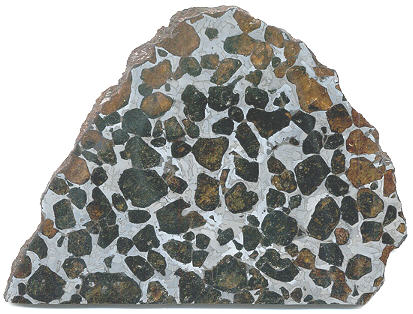
A 52.6 kg pallasite was found in Chihuahua, Mexico in 1909. This is a typical example of a main-group pallasite presumed to be synthesized from impact-crushed
mantleMain silicate-rich zone within a planet between the crust and metallic core. The mantle accounts for 82% of Earth's volume and is composed of silicate minerals rich in Mg. The temperature of the mantle can be as high as 3,700 °C. Heat generated in the core causes convection currents in Click on Term to Read More olivine and residual melt from the molten
coreIn the context of planetary formation, the core is the central region of a large differentiated asteroid, planet or moon and made up of denser materials than the surrounding mantle and crust. For example, the cores of the Earth, the terrestrial planets and differentiated asteroids are rich in metallic iron-nickel. Click on Term to Read More. The photo shown above is a 424 g partial slice, acquired from the Jim Strope Collection.
Mount Vernon—PMG
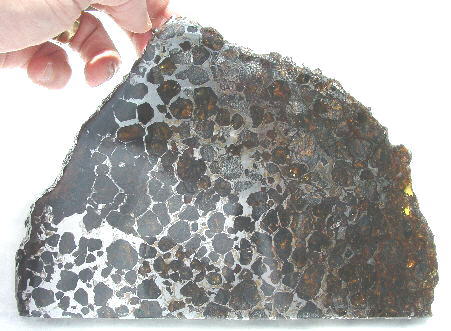
A 159.2 kg pallasite was found in Kentucky, USA, and recognized as a meteorite in 1902. This pallasite contains large, closely-spaced olivines with a size range of 5–25 mm in diameter. The photo shown above is a 1,507 g partial slice, acquired from the Robert Haag Collection, previously obtained in trade from the United States National Museum, Smithsonian Institution.
read more >>
Santa Rosalia—PMG
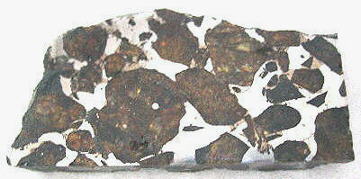
A 1,631 g pallasite was found by an Indian in Baja, Mexico, ~72 km WNW of Santa Rosalia, in the late 1940s. The pallasite was given to Pete Mahieux and then donated to H. H. Nininger for his museum, whereupon two slices were cut from the mass. Phosphate
REEOften abbreviated as “REE”, these 16 elements include (preceded by their atomic numbers): 21 scandium (Sc), 39 Yttrium (Y) and the 14 elements that comprise the lanthanides excluding 61 Promethium, an extremely rare and radioactive element. These elements show closely related geochemical behaviors associated with their filled 4f atomic orbital. Click on Term to Read More patterns and other data support the hypothesis that Santa Rosalia and certain other pallasites might have formed nearer the
parent bodyThe body from which a meteorite or meteoroid was derived prior to its ejection. Some parent bodies were destroyed early in the formation of our Solar System, while others like the asteroid 4-Vesta and Mars are still observable today. Click on Term to Read More surface, rather than at the core–mantle boundary. The photo above shows a 56 g partial slice, part of one of the two original slices made by Nininger. This specimen was acquired from the Robert Haag Collection, previously obtained in trade from Arizona State University, Center for Meteorite Studies.
Somervell County—PMG
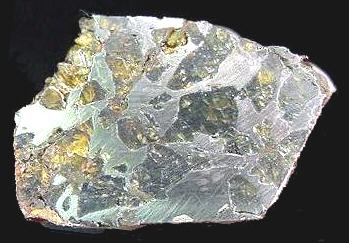
Three weathered fragments having a combined weight of 11.8 kg were found in Texas, USA in 1919, but not recognized as a meteorite until 1937. In an attempt to preserve this pallasite from further deterioration, Oscar E. Monnig encased the largest piece in plastic—but it was to no avail. In the photo above is a 51 g partial slice in relatively uncorrupted condition, acquired from the Rob Elliott Collection, previously obtained from Texas Christian University.
Quijingue—PMG
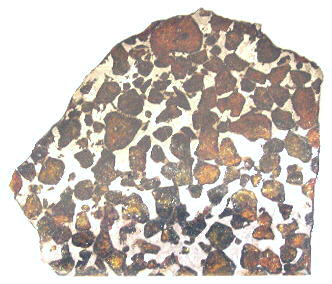
In 1984, while digging holes in which to plant trees for a fence row, a farmer in Bahia, Brazil uncovered a 59 kg pallasite. A second mass with a weight of 32 kg may have also been found. The farmer’s son gave the meteorite to a miner for use as an anvil, and a portion was eventually sent to the National Museum in Rio de Janeiro for identification. Quijingue is a main group pallasite that contains 72% olivine. The photo shown above is a 307 g partial slice, acquired from the Robert Haag Collection.
Pavlodar—PMG-am
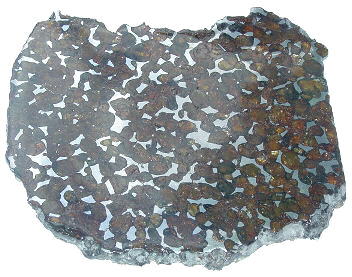
A mass weighing 4.5 kg was found in 1885 near the village of Jamysheva in the former USSR. Pavlodar contains a high volume of rounded silicates having a high Mn content. It has by far the lowest Au content in
metalElement that readily forms cations and has metallic bonds; sometimes said to be similar to a cation in a cloud of electrons. The metals are one of the three groups of elements as distinguished by their ionization and bonding properties, along with the metalloids and nonmetals. A diagonal line drawn Click on Term to Read More of any other pallasite, as well as the second highest Ir content. Because of its very anomalous composition, it’s been suggested that it formed in a unique environment on the PMG parent body (Wasson and Choi, 2003). The photo above shows a 272 g partial slice, acquired from the Field Museum of Natural History in Chicago.
NWA 2397—PMG
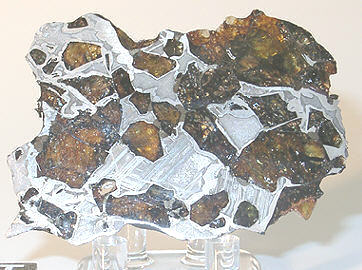
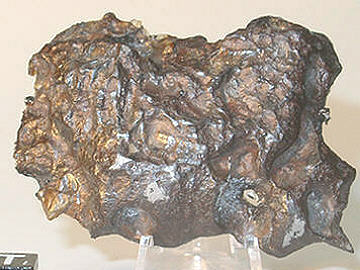
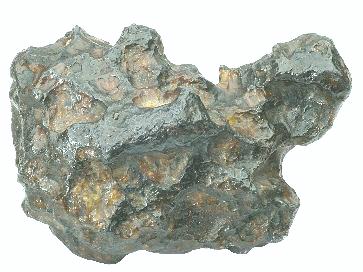
A single mass weighing 362 g was found in 1997 in Morocco. The meteorite was purchased in 1999 by a collector, and only a few sections have been distributed to date. The
fayalitePure* iron end-member (Fe2SiO4) of the olivine solid solution series and an important mineral in meteorites. When iron (Fe) is completely substituted by magnesium, it yields the the pure Mg-olivine end-member, forsterite (Mg2SiO4). The various Fe and Mg substitutions between these two end-members are described based on their forsteritic (Fo) Click on Term to Read More value of this beautiful pallasite was determined by Northern Arizona University to be ~12, which indicates that this is a main-group member. The two top photos show both sides of a 74.2 g end section cut from the
main massLargest fragment of a meteorite, typically at the time of recovery. Meteorites are commonly cut, sliced or sometimes broken thus reducing the size of the main mass and the resulting largest specimen is called the "largest known mass". Click on Term to Read More, which itself is shown in the bottom photo (photos not shown to the same scale).
Zinder—pyroxene-rich
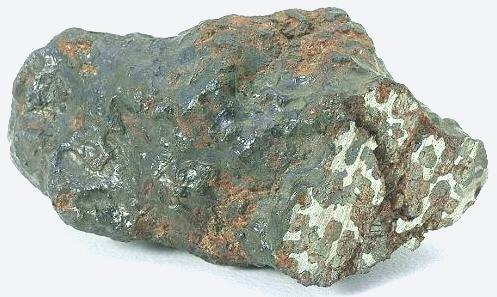
 A single fusion-crusted mass weighing 64 g was found in a field near Zinder, Niger in 1999, and it was subsequently purchased from the finder. Zinder has one of the highest pyroxeneA class of silicate (SiO3) minerals that form a solid solution between iron and magnesium and can contain up to 50% calcium. Pyroxenes are important rock forming minerals and critical to understanding igneous processes. For more detailed information, please read the Pyroxene Group article found in the Meteoritics & Classification category. Click on Term to Read More contents of any pallasite (~27 vol%), and has O-isotopic ratios that plot
A single fusion-crusted mass weighing 64 g was found in a field near Zinder, Niger in 1999, and it was subsequently purchased from the finder. Zinder has one of the highest pyroxeneA class of silicate (SiO3) minerals that form a solid solution between iron and magnesium and can contain up to 50% calcium. Pyroxenes are important rock forming minerals and critical to understanding igneous processes. For more detailed information, please read the Pyroxene Group article found in the Meteoritics & Classification category. Click on Term to Read More contents of any pallasite (~27 vol%), and has O-isotopic ratios that plot just above the terrestrial
fractionationConcentration or separation of one mineral, element, or isotope from an initially homogeneous system. Fractionation can occur as a mass-dependent or mass-independent process. Click on Term to Read More line (Bunch
et al., 2005). Boesenberg and Humayun (2019) demonstrated that NWA 1911 and Zinder are related. Although the metal in Zinder is chemically identical to that of group IIIF irons (Boesenberg
et al., 2017; Humayun
et al., 2018), the IIIF irons formed in the carbonaceous (C) region of the
Solar SystemThe Sun and set of objects orbiting around it including planets and their moons and rings, asteroids, comets, and meteoroids. beyond Jupiter, whereas the negative ε
54Cr and δ
26Mg* values of Zinder indicate that it formed in the non-carbonaceous (NC) region of the inner Solar
SystemDefinable part of the universe that can be open, closed, or isolated. An open system exchanges both matter and energy with its surroundings. A closed system can only exchange energy with its surroundings; it has walls through which heat can pass. An isolated system cannot exchange energy or matter with (Wimpenny
et al., 2019). The top photo above shows the complete mass after sectioning for study, and a magnified view of the cut face is shown below that. A scale view is shown
here.
Seymchan—PMG

As reported by Mednikov (1967) and others, a large mass was found in a stream bed of the Yasachnaya River by a geologist in the Magadan Region of the USSR (V. Buchwald, 1975). The triangular-shaped mass weighed 272.3 kg. A further search of the area resulted in the recovery of an additional 51 kg mass. The
iron meteoriteIron meteorites consist mostly of metallic iron alloyed with typically between ~5 to ~30 wt% nickel. The main metal phases are kamacite α-(Fe, Ni) and taenite y-(Fe, Ni). Based on their group classification, they may also contain a small weight percentage of one or more of the following minerals: • Click on Term to Read More was initially classified by J. Wasson (1974) as a member of chemical group IIE, but more precise elemental analyses of the IIE iron group by J. Wasson and J. Wang (1986) determined that Seymchan was not a typical IIE group member and was reclassified as an
ungroupedModifying term used to describe meteorites that are mineralogically and/or chemically unique and defy classification into the group or sub-group they most closely resemble. Some examples include Ungrouped Achondrite (achondrite-ung), Ungrouped Chondrite (chondrite-ung), Ungrouped Iron (iron-ung), and Ungrouped Carbonaceous (C-ung). Click on Term to Read More iron. New masses recovered very recently were found to contain silicates with a pallasitic texture, and new data indicate that this is a main-group pallasite (J. Wasson). Notably, Seymchan does have an anomalously high Ir content (van Niekerk
et al., 2007). The specimen shown above is a 7,160 g pallasitic slice of Seymchan.
read more >>
NWA 1911—pyroxene-rich
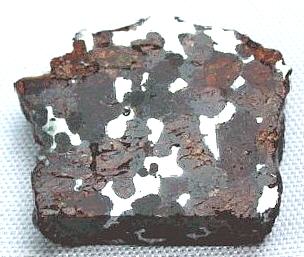
A fresh complete stone, weighing 53.07 g, was recognized by Mike Farmer in a batch of meteorites shipped to him from Rissani, Morocco in March 2003. Northwest Africa 1911 was found to have a modal composition of 24.3% FeNi-metal and 75% silicates, with the silicates consisting of 34.5%
orthopyroxeneOrthorhombic, low-Ca pyroxene common in chondrites. Its compositional range runs from all Mg-rich enstatite, MgSiO3 to Fe-rich ferrosilite, FeSiO3. These end-members form an almost complete solid solution where Mg2+ substitutes for Fe2+ up to about 90 mol. % and Ca substitutes no more than ~5 mol. % (higher Ca2+ contents occur Click on Term to Read More and 40.2% olivine—the highest pyroxene content recorded for a pallasite. Only three meteorites having pallasite-like compositions were recognized prior to the discovery of NWA 1911—Vermillion, Y-8451, and Zinder. The O-isotopic compositions of all four meteorites are distinct from each other, with only NWA 1911 plotting within the field of the main group pallasites. Boesenberg and Humayun (2019) demonstrated that NWA 1911 and Zinder are related. The specimen shown above is a 6.7 g slice of NWA 1911, acquired originally from M. Farmer.
read more >>
BACK TO PALLASITES: A Rare View
[ PART I ]














 A single mass weighing 362 g was found in 1997 in Morocco. The meteorite was purchased in 1999 by a collector, and only a few sections have been distributed to date. The fayalitePure* iron end-member (Fe2SiO4) of the olivine solid solution series and an important mineral in meteorites. When iron (Fe) is completely substituted by magnesium, it yields the the pure Mg-olivine end-member, forsterite (Mg2SiO4). The various Fe and Mg substitutions between these two end-members are described based on their forsteritic (Fo) Click on Term to Read More value of this beautiful pallasite was determined by Northern Arizona University to be ~12, which indicates that this is a main-group member. The two top photos show both sides of a 74.2 g end section cut from the main massLargest fragment of a meteorite, typically at the time of recovery. Meteorites are commonly cut, sliced or sometimes broken thus reducing the size of the main mass and the resulting largest specimen is called the "largest known mass". Click on Term to Read More, which itself is shown in the bottom photo (photos not shown to the same scale).
A single mass weighing 362 g was found in 1997 in Morocco. The meteorite was purchased in 1999 by a collector, and only a few sections have been distributed to date. The fayalitePure* iron end-member (Fe2SiO4) of the olivine solid solution series and an important mineral in meteorites. When iron (Fe) is completely substituted by magnesium, it yields the the pure Mg-olivine end-member, forsterite (Mg2SiO4). The various Fe and Mg substitutions between these two end-members are described based on their forsteritic (Fo) Click on Term to Read More value of this beautiful pallasite was determined by Northern Arizona University to be ~12, which indicates that this is a main-group member. The two top photos show both sides of a 74.2 g end section cut from the main massLargest fragment of a meteorite, typically at the time of recovery. Meteorites are commonly cut, sliced or sometimes broken thus reducing the size of the main mass and the resulting largest specimen is called the "largest known mass". Click on Term to Read More, which itself is shown in the bottom photo (photos not shown to the same scale).

 A single fusion-crusted mass weighing 64 g was found in a field near Zinder, Niger in 1999, and it was subsequently purchased from the finder. Zinder has one of the highest pyroxeneA class of silicate (SiO3) minerals that form a solid solution between iron and magnesium and can contain up to 50% calcium. Pyroxenes are important rock forming minerals and critical to understanding igneous processes. For more detailed information, please read the Pyroxene Group article found in the Meteoritics & Classification category. Click on Term to Read More contents of any pallasite (~27 vol%), and has O-isotopic ratios that plot just above the terrestrial fractionationConcentration or separation of one mineral, element, or isotope from an initially homogeneous system. Fractionation can occur as a mass-dependent or mass-independent process. Click on Term to Read More line (Bunch et al., 2005). Boesenberg and Humayun (2019) demonstrated that NWA 1911 and Zinder are related. Although the metal in Zinder is chemically identical to that of group IIIF irons (Boesenberg et al., 2017; Humayun et al., 2018), the IIIF irons formed in the carbonaceous (C) region of the Solar SystemThe Sun and set of objects orbiting around it including planets and their moons and rings, asteroids, comets, and meteoroids. beyond Jupiter, whereas the negative ε54Cr and δ26Mg* values of Zinder indicate that it formed in the non-carbonaceous (NC) region of the inner Solar SystemDefinable part of the universe that can be open, closed, or isolated. An open system exchanges both matter and energy with its surroundings. A closed system can only exchange energy with its surroundings; it has walls through which heat can pass. An isolated system cannot exchange energy or matter with (Wimpenny et al., 2019). The top photo above shows the complete mass after sectioning for study, and a magnified view of the cut face is shown below that. A scale view is shown here.
A single fusion-crusted mass weighing 64 g was found in a field near Zinder, Niger in 1999, and it was subsequently purchased from the finder. Zinder has one of the highest pyroxeneA class of silicate (SiO3) minerals that form a solid solution between iron and magnesium and can contain up to 50% calcium. Pyroxenes are important rock forming minerals and critical to understanding igneous processes. For more detailed information, please read the Pyroxene Group article found in the Meteoritics & Classification category. Click on Term to Read More contents of any pallasite (~27 vol%), and has O-isotopic ratios that plot just above the terrestrial fractionationConcentration or separation of one mineral, element, or isotope from an initially homogeneous system. Fractionation can occur as a mass-dependent or mass-independent process. Click on Term to Read More line (Bunch et al., 2005). Boesenberg and Humayun (2019) demonstrated that NWA 1911 and Zinder are related. Although the metal in Zinder is chemically identical to that of group IIIF irons (Boesenberg et al., 2017; Humayun et al., 2018), the IIIF irons formed in the carbonaceous (C) region of the Solar SystemThe Sun and set of objects orbiting around it including planets and their moons and rings, asteroids, comets, and meteoroids. beyond Jupiter, whereas the negative ε54Cr and δ26Mg* values of Zinder indicate that it formed in the non-carbonaceous (NC) region of the inner Solar SystemDefinable part of the universe that can be open, closed, or isolated. An open system exchanges both matter and energy with its surroundings. A closed system can only exchange energy with its surroundings; it has walls through which heat can pass. An isolated system cannot exchange energy or matter with (Wimpenny et al., 2019). The top photo above shows the complete mass after sectioning for study, and a magnified view of the cut face is shown below that. A scale view is shown here.








